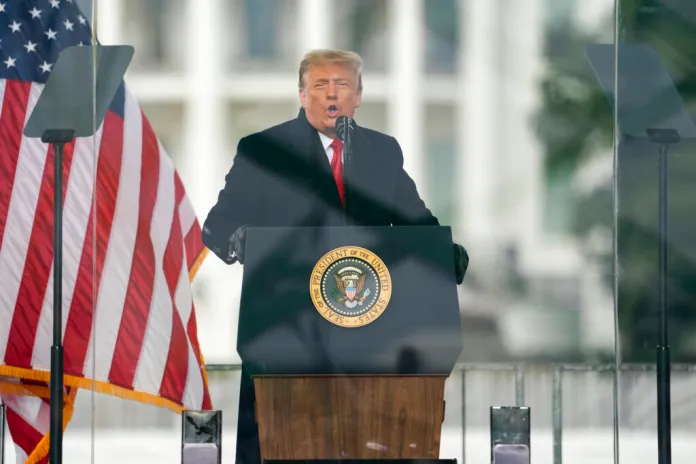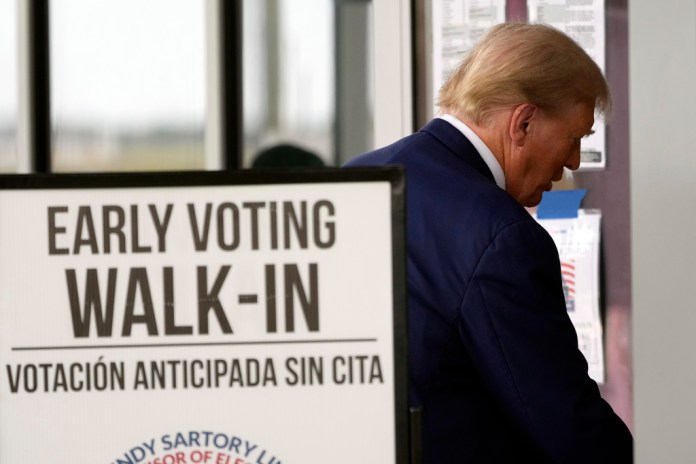Trump might not want to seek a third term even if he could
The article discusses the possibility of former President Donald Trump seeking a third term, despite the 22nd Amendment wich limits presidents to two terms. Trump’s frequent mention of this idea has led to speculation, especially among his supporters, about potential workarounds to this constitutional barrier. Historically, third terms for U.S. presidents have been rare, with many presidents experiencing diminished support when attempting a return to office after serving two terms. The article highlights meaningful past examples of presidents who entertained a third term but faced substantial obstacles, illustrating a ancient pattern of decline in voter support. It suggests that public weariness and historical precedents may impede Trump’s prospects for a successful third-term bid, regardless of legal constraints. The commentary by Joshua Spivak, a researcher, reflects on these trends and their implications for future elections.
Trump might not want to seek a third term even if he could
It wasn’t just George Washington that made third terms rare — presidents and governors wear out their welcome.
It’s a timely matter since President Donald Trump regularly raises the possibility of another White House term despite the seemingly impenetrable barrier of the 22nd Amendment. His supporters have also bandied about theoretical workarounds to the constitutional prohibition and promoted the idea through online merch, such as the MAGA red “Trump 2028” hat.
Trump may be the first president since the ratification of the 22nd Amendment to discuss extending his executive stay openly. But almost all two-term presidents had acolytes suggest that a third term would be a great thing. Even today, former President Barack Obama is being suggested as a candidate to take on Trump in a theoretical two-way, third-term rematch.
But there’s another way to look at the historical landscape. The 22nd Amendment may not be the only hurdle for a third presidential term. History suggests that presidents and even state executives are significantly weakened by the time they seek a third term.
There were attempts for that elusive third term before the 22nd Amendment’s ratification in 1951, nearly six years after the death of former President Franklin D. Roosevelt, who was elected four times. Surprisingly, it didn’t come up that often because serving two terms was unusual for a long period in U.S. history.
While five of the first seven presidents received two terms, in the 114 years between former President Andrew Jackson and the 22nd Amendment’s ratification, only four presidents managed to serve two full terms. The other two, Presidents Theodore Roosevelt and Harry Truman, spent more than one and a half terms due to the death of the presidents under whom they were vice president. Each of those six either ran or flirted with a third term.
The first, former President Ulysses S. Grant, did not seek reelection in 1876 to his party’s relief. But in 1880, he sought and failed in a quest for the Republican nomination for the presidency.
The next was former President Grover Cleveland, who, before Trump, was the first president to hold the office for nonconsecutive terms (1885-89 and 1893-97). But, perhaps in a prelude to Trump’s sagging second-term approval ratings, Cleveland’s return engagement in Washington, D.C., was a rough go. A month before Cleveland’s second presidency began, the Panic of 1893 sparked a severe national depression. Severe labor unrest, intra-Democratic Party fights over currency based on gold or silver, and deep political divides of U.S. expansion abroad added to his political headaches. After departing the White House a second time, Cleveland, having lost all influence among Democrats, was recruited for an opportunity to run for a third term as the standard-bearer of a third party. But he turned it down.
Theodore Roosevelt only won one term (he filled out almost four years of former President William McKinley’s abbreviated term after the president’s assassination). But in 1912, after nearly four years as a private citizen, Republicans at the party’s national convention in Chicago rejected his comeback bid — even though he demonstrated residual support among rank-and-file GOP voters by winning 9 out of 13 GOP primaries over former President William Howard Taft, his onetime hand-picked successor on whom he soured.
He instead ran the most successful third-party candidacy but still finished a distant second in the general election. He also failed to get the GOP nomination in 1916.
The weakened former President Woodrow Wilson appeared to have wanted a third term, but the Democrats rejected him in 1920, right before the party received the largest trouncing in U.S. history. And Truman, the last president to have a chance to seek his party’s nomination before the 22nd Amendment took effect, quickly turned down the opportunity after his supporters put up a poor showing in the New Hampshire primary in 1952.
This leads to the one exception — FDR won two extra terms. Notably, he came into office following the Great Depression and ran for his third term as the world descended into war. However, even under those circumstances, his 1940 effort engendered huge opposition from Democrats. But perhaps more important, there was pushback from voters. FDR did significantly worse in his third and fourth runs. In 1940, his vote total dropped 6% from 1936, then dropped another point in his fourth try in 1944. At least some of FDR’s multitude of supporters started tiring of him, even if not enough to lose the race.
The vote fall-off was a major departure from most presidential reelection runs, where the general rule is “do better or get out.” Only three times — former Presidents James Madison and Andrew Jackson, before all the states had popular vote, and Obama — has a president managed to fare worse in the popular vote in a reelection and still won the race. Only Madison, Obama, and Wilson managed to put up worse numbers in the Electoral College.
But perhaps there is an even more striking recent stat that draws out this fact. In the pre-Trump and pre-COVID-19 era, from 1952-2016, the party seeking a second straight term in office has been very successful, going 7-1, with only former President Jimmy Carter falling in a reelection run. However, anytime the party looked to extend the term for a third or further term since 1952, it has proven to be astonishingly unsuccessful. In 10 attempts, only former President George H.W. Bush won, succeeding former President Ronald Reagan, under whom he was vice president for eight years. Bush followed that up in 1992, with the lowest vote percentage of a major-party candidate since the only real three-party race in 1912.
Opposition to third terms may also be evident in gubernatorial races. It is not an exact match, as most states bar a third straight term (37 states, with nine of them banning any third term, and Virginia limiting governors to a single one before having to sit out for four years and try a comeback). Most governors run in midterm elections, where they face national environments quite different from a presidential election year.
Perhaps most useful to consider is that this group of governors is self-selecting. Truly unpopular governors likely would not attempt a third term. Since 1990, 38 governors have been able to run for a third full consecutive four-year term. Twenty-one did not choose this route, and 17 governors ran (New Hampshire and Vermont have two-year terms and are excluded). Of those, 14 won, but 10 times, the vote total in favor of the governor dropped from the previous election. Additionally, seven former governors ran after serving two full terms and then sitting out one or more terms from the office. In the case of former California Gov. Jerry Brown, he ran 28 years later. The reboots saw four wins and three losses, most recently former Maine Gov. Paul LePage in 2022.
This may suggest that governors retain an advantage, but unlike in reelections, they are likely to see support bleed off by the time they get to their third term. We may get a chance to test this further, as at least three Democratic governors who are possible 2028 presidential candidates, including Govs. JB Pritzker (D-IL), Tim Walz (D-MN), and Tony Evers (D-WI), are considering running for third terms in 2026 before any national race.
Right now, the talk of a 2028 run is just that. In a May 4 Meet the Press interview on NBC, Trump pulled back a bit by suggesting he won’t run.
THE NEW RIGHT: THE ISSUES, THE MAJOR PLAYERS, AND ITS FUTURE
We have a long 3 1/2 years ahead of us. Trump’s past third-term musing could just be trolling and a way to retain relevance and stave off the lame-duck blues. Though since Trump has been flirting with the idea since very early on, there may be good reason to think he is serious and might change his mind again.
But it may not be just the law that stops a third-term run. History shows that voters grow weary of presidents, executives, and one-party rule.
Joshua Spivak is a senior research fellow at UC Berkeley Law’s California Constitution Center and a senior fellow at the Hugh L. Carey Institution for Government Reform at Wagner College. He is the author of Recall Elections: From Alexander Hamilton to Gavin Newsom.
" Conservative News Daily does not always share or support the views and opinions expressed here; they are just those of the writer."




